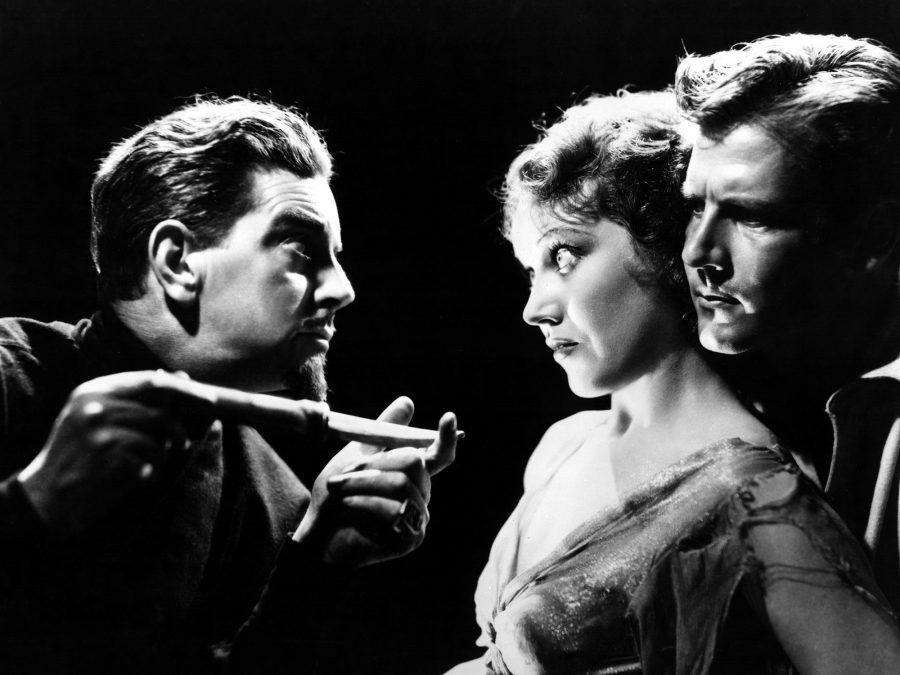Irving Pichel and Ernest P. Schoedsack’s The Most Dangerous Game opens, appropriately enough, with an entrance – a huge wooden door, on which there is a carving of a bestial figure with vampiric fangs and an arrow piercing his chest, holding in his arms an unconscious woman. As the titles appear, a hand reaches forward, and pulls several times on the carved woman – who it is revealed is also the door’s knocker.
Just when the door begins to creak open, there are two cuts, first to a pair of candles in front of a curtain, and then to a pair of ‘channel lights’ intended to mark the safe passage through a water’s treacherous reefs and shoals. There will be a shipwreck sequence out to sea before we return to the island fort with that elaborate door, but eventually a similar artwork will be seen on one of its interior walls, depicting a fanged centaur also holding an unconscious woman in his arms, even as he has been shot in the chest with an arrow from a nearby hunter.
These two artworks – the door sculpture and the mural – are mises en abyme, reflecting broader themes of the film in which they appear. For the scenario and dramatis personae that they portray – a monstrous mix of man and beast, his female prey and a hunter – are rôles that will also be found distributed between the three main characters of The Most Dangerous Game. When we first meet the protagonist, world-renowned American big game hunter Robert “Bob” Rainsford (Joel McCrea), he is aboard a passenger yacht and engaged in a debate with a doctor whose questions will reverberate throughout the film.
“I was thinking of the inconsistency of civilisation,” says the doctor. “The beast of the jungle killing just for his existence is called savage. The man, killing just for sport, is called civilised. It’s a bit contradictory, isn’t it?”. Here the doctor is pointing out the proximity, perhaps even the indistinguishability, between civilisation and savagery, humanity and bestiality, as though a hunter, like that hybrid creature on the artwork, somehow straddles both.
“This world’s divided into two kinds of people, the hunter and the hunted,” replies Rob, “Now luckily I’m a hunter, and nothing can ever change that…” – but Rob’s words are violently cut off, and his meaning undermined, when the boat suddenly runs aground on a reef. The sole survivor of this collision will be Rob, who manages to swim away from the sunken vessel.
Washing up ashore on a nearby island, Rob heads to the only man-made structure there, entering by that large door with the sculpted knocker. Now he is in the domain of Count Zaroff (Leslie Banks), a nobleman exiled from post-Revolution Russia who, with a small, loyal staff of Cossack servants, has taken over the island and turned it into his private hunting grounds.

Having read all Rob’s books, Zaroff is delighted to have such a celebrity in his own home. He introduces Rob to his other two guests, Eve Trowbridge (Fay Wray) and her dipsomaniac brother Martin (Robert Armstrong) who had survived a previous shipwreck along with two sailors who have since mysteriously disappeared. As Zaroff talks of having discovered a way to pursue ‘the most dangerous game’ on his island, it will gradually dawn on Rob that Zaroff is hunting humans whom he has ensnared there – and the American must decide whether he is Zaroff’s partner in blood sports, or his next quarry, as the great hunter becomes the hunted and will for the first time discover how it feels to be cornered prey.
Shot at night on the same jungle sets as Merian C. Cooper and Ernest P. Schoedsack’s King Kong (1933) with several overlapping cast (Wray, Armstrong, Noble Johnson and James Flavin) and crew, The Most Dangerous Game similarly confounds human and animal. Adapted from Richard Connell’s 1924 short story of the same name, it has itself had an untold influence on subsequent cinema.
While films like Peter Watkins’ Punishment Park (1971) and Kleber Mendhonça Filho and Juliano Domelles’ Bacurau (2019) have carefully converted the manhunt premise for politically pointed allegory, The Most Dangerous Game broadly follows the request that a drunken Martin gives to Zaroff at the piano: “Not highbrow like last night, just a good tune.”
For like Ralph Brooke’s Bloodlust! (1961), Brian Trenchard-Smith’s Turkey Shoot (1982), John McTiernan’s Predator (1987), John Woo’s Hard Target (1993), Ernest R. Dickerson’s Surviving the Game (1994) and Craig Zobel’s The Hunt (2020), this is all about the thrill of the chase.
As a pre-Code horror, The Most Dangerous Game has a real nastiness to it too. Even before Rob has reached the island, the shipwreck leads to the crew being boiled alive in the flooded engine room and men in the water taken by sharks; Zaroff’s basement ‘trophy room’ is not only decorated with the preserved heads of those he has previously hunted, but is also a torture chamber; and while Zaroff does not intend to murder Eve (“one does not kill a female animal,” he assures Rob in typically dehumanising language), his designs on her nonetheless clearly constitute rape (“Only after the kill,” he says, meaning Rob’s death, “does man know the true ecstasy of love”).
There is, amid all this sensationalist material, an ongoing discourse on what it means to be human, and how far a man should be willing to go, as Zaroff puts it, to “follow his convictions to their logical conclusion.” Some doors evidently should never be opened, and some thresholds never crossed.
The Most Dangerous Game is released for its 90th Anniversary in its UK debut on Blu-ray, from a 2K restored scan, as part of Eureka Video’s The Masters of Cinema series, 24th Oct 2022.
The post Discover the haunting human horrors of this Pre-Code classic appeared first on Little White Lies.


0 Comments